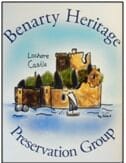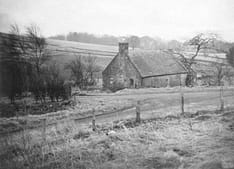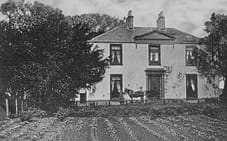Place Names in and Around Benarty
Balbedie The lands of Wester Balbedie constituted a detached portion of the parish of Ballingry until 1891 when they were annexed to the parish of Portmoak.
Ballingry Certain evidence points to the likelihood that the estate of Ballingry went over to the Culdees of St. Serfs Priory along with neighbouring lands in the gift made by Macbeth and his queen Gruoch to the clergy in the eleventh century at which period Ballingry lay outwith Lochoreshire. The early form of the name may have been Baile-an-Gruoch, meaning the abode of Gruoch. Gruoch well lies a little to the south of Ballingry farm.
Benarty Hill Attaining a height of 1,131 feet *, it forms a ridge between Lochleven and Loch Ore. It is of the Crag-and-tail formation, a relic of the Ice-Age. The oldest form of the name is to be found in the Register of the Priory of St. Andrews. The name is said to commemorate the British King Arthur of the Dark-Age period and means Arthur’s ridge. *Editors note, the height of the hill has recently been set at 1,168 feet. http://www.scottish-places.info/features/featurefirst419.html
Boar Park A large piece of open ground situated in South Glencraig used mainly for recreational purposes. The name is of uncertain origin as it does not appear in any of the old writings, but as it was part of a Common, it may have been used for herding swine.
Candelmakers Row A row of twelve single-apartment houses which, along with others, were built by Lochore and Capeldrae Coal Co. on ground belonging to Hynds farm. The houses faced Lochleven Road. The name recalls a well known row of houses in Edinburgh. Candlemakers Row was demolished in 1924.
Capeldrae (Chapel Among Thorns) The lands of Capeldrae lie within the parish of Auchterderran. The “place” of this name being so close to Ballingry as to appear to be part of it, has from the earliest of times has been associated with Ballingry.
Caravan Row A row of sixteen single-apartment houses which stood beside a little lochan on ground belonging to Hynds farm. It was so called from the house having segmental roofs which were tar-felted similar to the roof of a caravan.
Chapel Farm The steading of Chapel farm was built by John Syme about the year 1811 in order to work the ground formerly covered by Loch Ore. The steading occupied the site of the Castle of Lochore where the Chapel of Lochore was also situated.
Cleikum Inn
A hitherto unnamed cotter’s house belonging to the Benarty estate which was acquired by Lady Scott in 1825 as a lodge at the west entrance to Lochore estate and thereafter given the name of Cleikum Inn by Sir Walter Scott.
Clune The lands of Clunie stretched from Loch Ore southward to the River Fitty. They were bounded by the parish of Beath in the west and probably did not extend beyond the public highway in the east.
Clunecraig (Meadow of the rock) The old name for the land occupied by the former village of North Glencraig. It appears to have embraced all the lands of Clune and some land on the east side of the public road lying immediately on the north side of the River Fitty.
Craigie-Malcolm The prefix “Craigie” is of modern usage. The name appears to have been Moncloccaham a local boundary land name which appears about the year 1400 of which Malcolm is a corruption. MonCloccodham “the hill of the helmit”, may refer to the morainic mound which is such a conspicuous land-mark at this place.
Crosshill The old charters refer to the lands of Crosshill as “terras de Corshill supra Inchgall” which seems to suggest that the cross stood on high ground above the island of Inchgall, hence the name. Crosshill was made a burgh of the barony in 1511.
Dandy Rows Consisted of two parallel rows of houses containing twenty five houses in all. The houses were built on a site of a former lochan and lay between Caravan Row and Lochleven Road. They were of two apartments and looked upon as superior to their neighbours, hence the name.
Dumbiedykes Originally the farm house of Hynds. When the grounds attached to the farm were taking over for the building of the village of Lochore, the farm house was divided Into flats. It was then that the building was renamed Dumbiedykes after the Edinburgh house of that name which appears in Scott’s novel “The Hearst of Midlothian” published in 1818.
Dunmore (Big hill) A rocky knoll of considerable height situated on the eastern ridge of Benarty Hill overlooking Ballingry Farm. The igneous rock tends to present a columnar formation.
Elders Knowe A rocky knoll forming part of Kildownie Hill, situated north-west of Lochore House.
Fairnsdale The name given to a site on Benarty Hill lying almost opposite the entrance to Benarty House. Traces of two turf-walled enclosures indicate early husbandry.
Flockhouse (Sheep House) The Flockhouse is one of the few houses named in the old charters dealing with the barony of Inchgall. It always appears along with the “Bowhouse”. As the name suggest, it was the abode of a shepherd as is stated in the year 1605. It was ruinous by 1854. The house occupied the site of the present Police Station.
Glebe, The The Glebe lands of Ballingry were situated opposite the entrance to Ballingry Manse, occupying a corner site and extending some considerable distance on the south side of the Hill Road. The lands are now entirely built upon. The rent of the Glebe lands in 1819 was assessed at £18 per annum. The glebe extended to 8 ¼ acres.
Glencraig The estate of Glencraig came into being about 1830. It comprised the small estate of Inchgall, (adjoining Inchgall mill) Contle, Clune and Templelands.
Gruoch’s Well so called from Macbeth’s queen, it is a natural spring situated on the high ground almost directly above the farm cottage at Ballingry Farm. The spring is a source of Lochty Burn.
Halfmoon Park Called from its forming the greater part of a half circle. It lies at the western extremity of Ballingry estate and occupies the lower slope of Benarty Hill. The park extends to thirteen acres.
Harelaw Cairn (Boundary Hill) A Bronze-age burial cairn lying approximately one mile to the east of Crosshill. The cairn was excavated by Ballingry Antiquarian Club in 1890-91 when two food vessels were found containing human remains.
Harran Hill Also known as the Bowhouse Bank from its having on its upper part the small steading of the Bowhouse of Inchgall. The name may be derived from the Scots word, harrow or harra, the name given to the agricultural implement for breaking up ground after ploughing. The hill bears on its surface a remarkable series of deep cuts, evidence of early cultivation using the Scottish wooden plough which was usually pulled by a team of oxen. “Harran” was the name given to a coarse cloth made from the “hards” of flax or hemp, but it does not seem appropriate to apply it in this instance.
Inchgall Inchgall, the island in Loch Ore gave its name to the castle built upon it and to the barony. The island was roughly pear-shaped. Its main axis lay due north and south. The castle occupied the broadest part which lay to the north. The name was probably coined about the year 1295.
Inchgall Castle This castle which stood on the island of Inchgall in Loch Ore, was built by the Vallance family probably during the last quarter of the thirteenth century or shortly afterwards. It was in being in 1308.
Kirklands In researching the various lands that made up the parish of Ballingry, one is struck by the number that at one time belonged to the church or bore an ecclesiastical connotation. Starting in the south and preceding northward, the name Lumphinnans suggest that a church stood in the neighbourhood at some remote period, built by the early followers of St Finnan. The Templelands of Inchgall belonged to the religious-military order of the Knights Templars. Easter and Wester Crosshill recall the existence of a Christian cross. The northern half of Wester Crosshill was also known as Kirkhill and sometimes Kirklands. The lands on which the eastern half of the township of Ballingry is built upon, including Craigie-Malcolm, were originally known as Kirklands. To the east of Ballingry stands the farm of Kirklands and the land to the east of the farm steading are still called Kirklands. The estate of Ballingry also belonged to the Church and Navite estate was also Church property at an early date.
Loan Head The lands, consisting of 8 acres on the south side of the west approach to Lochore House and east of Harran plantation. The name was given to a row of houses which stood to the east of the cross-roads in the village known as Loanhead Avenue.
Lochcraig The name given to a small portion of the Glencraig estate lying between the Ore Bridge and Spail Inn Brae. The name was coined prior to 1890.
Loch Ore The loch varied in size according to the seasons of the year from one hundred and fifty to two hundred acres. It’s average depth of forty feet in certain places. It was fed from three sources – The Kelty Burn, The Ladath Burn and a stream which had it source in a lochran in the vicinity of Tushielaw. Attempts to drain the loch were made in 1792 and 1795.
Lochore The name has received many interpretations. The one which appears most probable takes into account its earliest form, i.e. Lochor. In the languages of the period, Latin, Anglo-French and Gaelic, “Or” denotes gold, so that the name may mean “The loch of the gold”. In by-gone times gold was found in Benarty Hill. Gold-bearing rock was also found in the old Benarty Coal Mine.
Lochore Family The Lochore family was descended from the old Celtic Mormaers of Fife through the House of Macduff in the person of Hugo, son of Gillimichael Macduff, Earl of Fife who, on receiving certain lands in Lochoreshire styled himself Hugo De Lochore, and Sheriff of Fife, whose two daughters became heiresses of the estate.
Lochore Golf Club The club was formed in 1907.The game was played on a field to the south of Harelaw Cairn and owing to the slope of the ground, the fairways were laid out across the hill. Three years afterwards, a much improved course was constructed on the lands of Easter Crosshill when the name of the club was changed to Ballingry Golf Club. The club failed to survive the Second World War. Golf is known to have been played on Benarty Hill prior to 1885.
Lochore House Lochore House (originally Inchgall House) was built by the Malcolm family between 1654 and 1661 on what was then Ladath Estate. The courtyard and servants quarters to the rear of the house have been removed. The interior has been largely gutted.
Meadows, The This name has come into much prominence in recent years. It refers to the ground reclaimed following the draining of Loch Ore and refers in particular to the ground lying to the west of Inchgall Castle. It amounted to forty four acres. The remainder of the land added to the Lochore estate formerly covered by the loch amounted to seventy four acres. The lands lying on the south side of the main drainage ditch were added to the Clunycraig estate, as it was then called.
Milton, The The Milton of Inchgall lay on the east side of the public road and extended from the River Ore northward to Crosshill Cottage. It embraced the main lands of Inchgall farm steading of that name.
Muckle Stane Cottage This house was originally a recruiting depot during the First World War. It consisted of a shooting range with two rooms attached, occupied by a retired soldier by the name of Fred McGovern who acted as recruiting officer. After the war, it was converted into a chapel to serve the Catholic community. Following the erection of the near-by Roman Catholic school-cum-chapel, the building was converted into a residence for the parish priest. It afterwards belonged to the Fife Coal Company and subsequently to the National Coal Board. It is now a private residence. It received its name from an outcrop of rock (the muckle stane) which is to be seen a little distance to the east of the house.
Navitie The lands of Navitie lie between Kirkness and Ballingry estate. The root from which the name is derived is said to be pre-Christian and denotes a hallowed meeting place. The lands of Navitie, having been wadset, were redeemed in 1549 for the sum of 100 mersk Scots. Navitie House, the second to stand on the site, was built by Lieutenant Colonel Lindsay of the East India Company.
Navitie, Shank of This name is given to the short stretch of road after it crosses the Lochty Burn till it passes the entrance to Navitie House. It was until fairly recently a beautiful avenue of trees.
Paran Well The name not only denotes the presence of a well but it was at one time a “place”, there being a cluster of houses close-by. The lands adjoining were known as the Templelands of Bin in which the Church of Ballingry had an interest. Being one of the Church’s “investments” the rent from the land was set aside for the benefit of the poor of the parish. It was here that an attempt was made in 1564 to waylay Mary, Queen of Scots and Lord Darnley as they rode from Perth to Queensferry. Paren Well is mentioned in the novel “At Heart a King” by Alice Harwood published in 1957
Rose Well This well was situated in the vicinity of the cross-roads at the north end of the village of Lochore. The overflow from the well ran into a small lochan which lay in the low ground on the west side of the public road now occupied by the village bowling green.
St Ronans Place The name given to two workmens’ houses which stood a little northward of the No1 mine belonging to the Lochore and Capeldrae Coal Company. The name recalls Scott’s novel “St Ronan’s Well” published in 1823.
Tushielaw (Hill of the Coltsfoot)
Tushielaw cottage stood on the site of the present Miners’ Welfare Institute and although in Crosshill, the lands on which it stood were further defined as Kirk Lands.
Extracts from Henderson, E. (1990) A Parish Alphabet.





